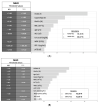Application of a Machine Learning Technology in the Definition of Metabolically Healthy and Unhealthy Status: A Retrospective Study of 2567 Subjects Suffering from Obesity with or without Metabolic Syndrome
- PMID: 35057554
- PMCID: PMC8779369
- DOI: 10.3390/nu14020373
Application of a Machine Learning Technology in the Definition of Metabolically Healthy and Unhealthy Status: A Retrospective Study of 2567 Subjects Suffering from Obesity with or without Metabolic Syndrome
Abstract
The key factors playing a role in the pathogenesis of metabolic alterations observed in many patients with obesity have not been fully characterized. Their identification is crucial, and it would represent a fundamental step towards better management of this urgent public health issue. This aim could be accomplished by exploiting the potential of machine learning (ML) technology. In a single-centre study (n = 2567), we used an ML analysis to cluster patients with metabolically healthy (MHO) or metabolically unhealthy (MUO) obesity, based on several clinical and biochemical variables. The first model provided by ML was able to predict the presence/absence of MHO with an accuracy of 66.67% and 72.15%, respectively, and included the following parameters: HOMA-IR, upper body fat/lower body fat, glycosylated haemoglobin, red blood cells, age, alanine aminotransferase, uric acid, white blood cells, insulin-like growth factor 1 (IGF-1) and gamma-glutamyl transferase. For each of these parameters, ML provided threshold values identifying either MUO or MHO. A second model including IGF-1 zSDS, a surrogate marker of IGF-1 normalized by age and sex, was even more accurate with a 71.84% and 72.3% precision, respectively. Our results demonstrated high IGF-1 levels in MHO patients, thus highlighting a possible role of IGF-1 as a novel metabolic health parameter to effectively predict the development of MUO using ML technology.
Keywords: artificial intelligence; insulin-like growth factor 1; metabolic syndrome.
Conflict of interest statement
The authors declare no conflict of interest.
Figures


References
-
- Gómez González E., Gómez Gutiérrez E. Artificial Intelligence in Medicine and Healthcare: Applications, Availability and Societal Impact. Publications Office of the European Union; Luxembourg: 2020. [(accessed on 13 January 2022)]. Available online: https://publications.jrc.ec.europa.eu/repository/handle/JRC120214.2001.09778
-
- Giorda C.B., Pisani F., De Micheli A., Ponzani P., Russo G., Guaita G., Zilich R., Musacchio N. Determinants of good metabolic control without weight gain in type 2 diabetes management: A machine learning analysis. BMJ Open Diabetes Res. Care. 2020;8:e001362. doi: 10.1136/bmjdrc-2020-001362. - DOI - PMC - PubMed
-
- Singh B., Tawfik H. Machine Learning Approach for the Early Prediction of the Risk of Overweight and Obesity in Young People. In: Krzhizhanovskaya V.V., Závodszky G., Lees M.H., Dongarra J.J., Sloot P.M.A., Brissos S., Teixeira J., editors. Proceedings of the Computational Science—ICCS 2020. Springer International Publishing; Cham, Switzerland: 2020. pp. 523–535.
Publication types
MeSH terms
Substances
LinkOut - more resources
Full Text Sources
Medical
Miscellaneous

